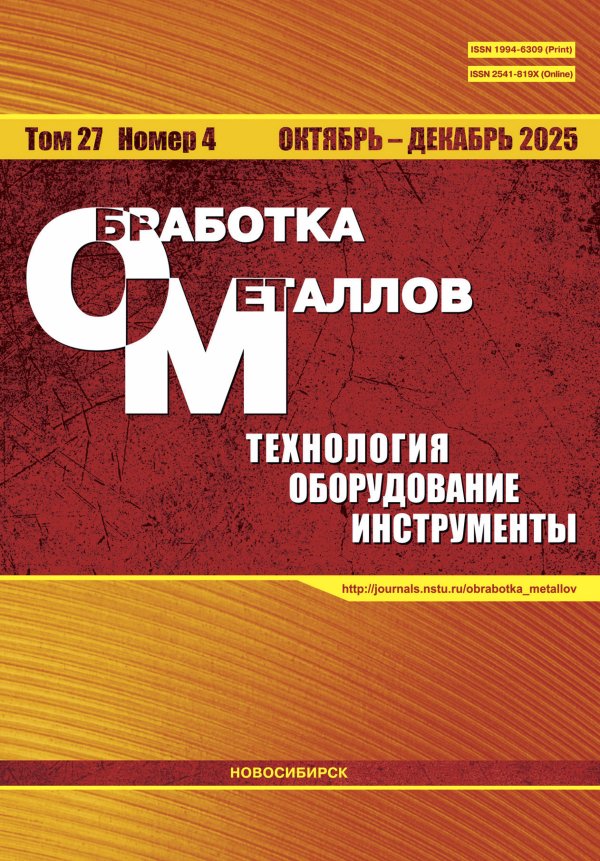Особенности закалочного деформирующего резания
- Авторы: Зубков Н.Н.1, Васильев С.Г.1, Попцов В.В.1
-
Учреждения:
- Выпуск: Том 20, № 2 (2018)
- Страницы: 35-49
- Раздел: ТЕХНОЛОГИЯ
- URL: https://journal-vniispk.ru/1994-6309/article/view/302064
- DOI: https://doi.org/10.17212/1994-6309-2018-20.2-35-49
- ID: 302064
Цитировать
Полный текст
Аннотация
Ключевые слова
Об авторах
Н. Н. Зубков
Email: zoubkovn@bmstu.ru
доктор технических наук, профессор, Московский государственный технический университет имени Н.Э. Баумана, zoubkovn@bmstu.ru
С. Г. Васильев
Email: sergv@bmstu.ru
кандидат технических наук, доцент, Московский государственный технический университет имени Н.Э. Баумана, sergv@bmstu.ru
В. В. Попцов
Email: poptsov-v.v@yandex.ru
ООО "Секо Тулс", poptsov-v.v@yandex.ru
Список литературы
- Rajan T.V., Sharma C.P., Sharma A. Heat treatment principles and techniques. – Delhi, India: PHI Learning, 2011. – 408 p. – ISBN 812030716X.
- Davis J.R. Surface hardening of steels understanding the basics. – Materials Park, OH, USA: ASM International, 2002. 319 p. – ISBN 0871707640.
- Guo Y.B., Janowski G.M. Microstructural characterization of white layers by hard turning and grinding // Transactions of NAMRI/SME. – 2004. – Vol. 32. – P. 367–374.
- Упрочнение покрытий специальным точением / С. Скобло, В.В. Коломиец, В.Ф. Ридный, Р.В. Ридный // Вісник СевНТУ. – 2010. – № 110. – C. 208–211.
- Experimental investigation of hard turning / S. Naik, C. Guo, S. Malkin, D.V. Viens, C.M. Pater, S.G. Reder // 2nd International Machining and Grinding Conference. – Dearborn, MI, 1997. – P. 224–308.
- Surface layer microhardness changes with high-speed turning of hardened steels / J. Kundrak, A.G. Mamalis, K. Gyani, V. Bana // International Journal of Advanced Manufacturing Technology. – 2011. – Vol. 53 (1). – P. 105–112.
- Liu Z.Q., Ai X., Wang Z.H. A comparison study of surface hardening by grinding versus machining // Key Engineering Materials. – 2006. – Vol. 304–305. – P. 156–160.
- An investigation of the grinding-hardening induced by traverse cylindrical grinding / T. Nguyen, M. Liu, L. Zhang, Q. Wu, D. Sun // Journal of Manufacturing Science and Engineering. – 2014. – Vol. 136 (5). – P. 051008-1–05100-10. – doi: 10.1115/1.4028058.
- Hyatt G. Integration of heat treatment into the process chain of a mill turn center by enabling external cylindrical grind-hardening // Production Engineering – Research and Development. – 2013. – Vol. 7 (6). – P. 571–584. – doi: 10.1007/s11740-013-0465-3.
- Patent 5775187 U.S. Method and apparatus of producing a surface with alternating ridges and depressions / N. Zoubkov, A. Ovtchinnikov. – N 8/545,640; appl. date 27.04.1994; publ. date 07.07.21998.
- Патент 2556897 Российская Федерация. Способ поверхностного закалочного упрочнения режуще-деформирующим инструментом / Н.Н. Зубков, С.Г.Васильев, В.В. Попцов. – № 2014101642/02; заявл. 21.01.2014; опубл. 20.07.2015, Бюл. № 20.
- Kukowski R. MDT – Micro deformation technology // Proceedings of ASME 2003 International Mechanical Engineering Congress and Exposition. – Washington, DC, 2003. – P. 305–308.
- Boiling heat transfer of different liquids on microstructured surfaces / I.A. Popov, A.V. Shchelchkov, N.N. Zubkov, R.A. Lei, Yu.F. Gortyshov // Russian aeronautics. – 2014. – Vol. 57, N 4. – P. 395–401. – doi: 10.3103/S1068799814040138.
- Investigation of heat transfer in evaporator of microchannel loop heat pipe // A. Yakomaskin, V. Afanasiev, N. Zubkov, D. Morskoy // Journal of Heat Transfer. – 2013. – Vol. 135 (10). – Art. 101006. – doi: 10.1115/1.4024502.
- Novel electrical joints using deformation machining technology. Part I: Computer Modeling / L. Solovyeva, N. Zubkov, B. Lisowsky, A. Elmoursi // IEEE Transactions on Components, Packaging, and Manufacturing Technology. – 2012. – Vol. 2 (10). – P. 1711–1717. – doi: 10.1109/TCPMT.2012.2207723.
- Novel electrical joints using deformation machining technology. Part II: Experimental verification / L. Solovyeva, N. Zubkov, B. Lisowsky, A. Elmoursi // IEEE Transactions on Components, Packaging, and Manufacturing Technology. – 2012. – Vol. 2 (10). – P. 1718–1722. – doi: 10.1109/TCPMT.2012.2199755.
- Zubkov N.N., Sleptsov A.D. Influence of deformational cutting data on parameters of polymer slotted screen pipes // Journal of Manufacturing Science and Engineering. – 2016. – Vol. 138, N 1. – P. 011007-1–011007-7. doi: 10.1115/1.4030827.
- Klocke F. Manufacturing processes. 1. Cutting. – Berlin: Springer, 2011. – 504 p. – ISBN 978-3-642-11978-1. – doi: 10.1007/978-3-642-11979-8.
- Chou S.K., Evans C.J. White layers and thermal modeling of hard turning surfaces // International Journal of Machine Tools & Manufacture. – 1999. – Vol. 39. – P. 1863−1881.
- Григорьянц А.Г., Шиганов И.Н., Мисюров А.И. Технологические процессы лазерной обработки. – М.: Изд-во МГТУ им. Н.Э. Баумана, 2006. – 663 c. – ISBN 978-5-7038-2701-7.
- Mohamad A. Wear performance of a laser surface hardened ASTM 4118 Steel // Engineering and Technology Journal. – 2013. – Vol. 31, N 17. – P. 2335–2344.
- Маслов А.Р. Резание металлов в современном машиностроении. – М.: ИТО, 2008. – 299 c. – ISBN 5-94275-049-1.
- Чиркин В.С. Теплофизические свойства материалов ядерной техники. – М.: Атомиздат, 1968. – 483 c.
- Davim P. Machining of hard materials. – London: Springer, 2011. – 211 p. – ISBN 978-1-84996-449-4. – doi: 10.1007/978-1-84996-450-0.
- Burakowski T., Wierzchon T. Surface engineering of metals: principles, equipment, technologies. – Boca Raton, FL: CRC Press, 1998. – 592 p. – ISBN 9780849382253.
- Altgilbers L. Explosive pulsed power. – London, UK: Imperial College Press, 2011. – 596 p. – ISBN-10: 1848163223.
- Majumdar J.D., Manna I. Laser-assisted fabrication of materials. – Berlin: Springer, 2013. – 485 p. – ISBN 978-1848163225.
- Оценка триботехнических характеристик стали 40Х после закалки деформирующим резанием [Электронный ресурс] / С.Г. Васильев, А.Г. Дегтярева, Н.Н. Зубков, В.В. Попцов, В.Н. Симонов // Инженерный журнал: наука и инновации. – 2017. – № 11. – URL: http://engjournal.ru/articles/1698/1698.pdf (дата обращения: 14.05.2018). – doi: 0.18698/2308-6033-2017-11-1698.
Дополнительные файлы







